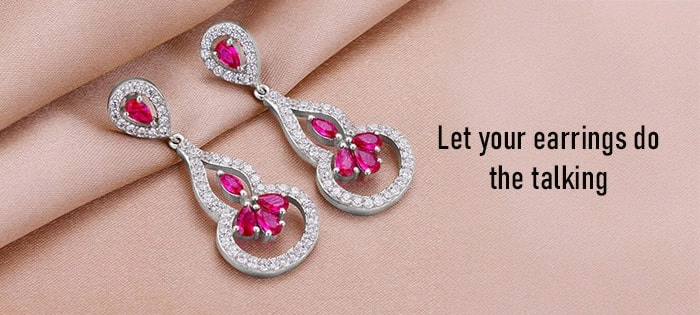Why Mixing Metals Is the Biggest Jewelry Trend Right Now
Gone are the days of “matchy-matchy” jewelry sets. Today, mixing metals is all about intentional eclecticism—combining gold, silver, and rose gold to create unique, eye-catching looks that feel personal and modern. It’s no longer about sticking to one metal; it’s about blending tones to express your style with confidence and flair.
Social media platforms like TikTok and Instagram have accelerated this trend faster than ever. Influencers, stylists, and everyday fashion lovers are sharing their best mixed-metal combos, fueling a global love for layering different metal jewelry in fresh, unexpected ways.
Top designers and luxury brands have caught on, too. Tiffany, Cartier, Mejuri, and others are launching mixed-metal collections, proving that this isn’t just a passing fad—it’s a new standard in jewelry. When the biggest names in the industry embrace mixing metals, you know it’s officially the style to try.
The Golden Rule of Mixing Metals (Yes, There’s Still One)
While mixing metals feels playful and free, there’s one solid rule to keep your look polished: balance and intention. A reliable formula is following a 70/30 or 60/40 ratio, where one metal takes the lead as the dominant tone, and the others serve as accents. For example, if gold is your main metal, use silver or rose gold as highlights rather than equal parts of each.
Choosing a dominant metal helps anchor your outfit, making the mix look intentional instead of random. Scale and proportion also matter—larger pieces in your dominant metal paired with smaller, delicate accents in other metals create a cohesive and layered effect. Mixing equal amounts of all metals or clashing big statement pieces risks a chaotic look.
Keep in mind, the key is harmony: one metal sets the mood, and the others add just enough variety to keep it fresh and modern without overwhelming. This approach is a core part of the modern metal mixing rules embraced in the mixed metal jewelry trend 2025.
Understanding Metal Tones & Skin Undertones
Knowing how metal tones work with your skin undertone makes mixing metals much easier and far more flattering. Generally, metals fall into two groups: warm tones and cool tones.
- Warm metals: yellow gold, rose gold
- Cool metals: white gold, silver, platinum
How to Find Your Skin Undertone
There are three main undertones to consider: warm, cool, and neutral. Here’s a simple way to check:
- Look at the veins on your wrist.
- If they appear greenish, you likely have a warm undertone.
- If they look blue or purple, you’re probably cool-toned.
- If it’s hard to tell, you might have a neutral undertone.
Best Metal Combinations by Skin Tone
- Fair skin: Cool metals like silver and white gold highlight fair complexions beautifully. Mix these with hints of rose gold for a soft contrast.
- Medium skin: This tone can handle both warm and cool metals. Try mixing yellow gold with white gold or silver for a balanced look.
- Olive skin: Warm metals like yellow and rose gold complement olive undertones well, but adding touches of silver can add a fresh twist.
- Deep skin: Warm metals, especially rose gold and yellow gold, really pop on deeper skin. Mixing with platinum or white gold adds elegance and dimension.
Mixing metals based on your undertone helps your jewelry look intentional and enhances your natural glow. Don’t be afraid to experiment with combinations—you might find a new favorite mix!
Core Mixing Techniques That Always Work
Starting with the Two-Tone Foundation is the easiest way to dive into mixing metals. Pick one metal as your base—say gold—and add silver or rose gold as accents. This keeps your look balanced without going overboard.
For those ready to step it up, the Three-Metal Stack is a stylish move. Combining gold, silver, and rose gold works best when each metal gets its own space—think layered bracelets or stacked rings with clear separation. This way, the mix looks intentional, not messy.
The “Metal Sandwich” Trick is a clever way to mix metals in rings and bracelets. Layer a silver piece between two gold bands or vice versa. It frames the middle metal, creating a neat, cohesive look.
Don’t overlook oxidized or mixed-metal pieces as natural bridges. These jewelry items blend darker tones with shiny metals, tying different metals together smoothly.
Jewelry-Type-Specific Mixing Guides
Necklaces: Layering Rules & Lengths
When mixing metal necklaces, keep these tips in mind:
- Vary lengths to avoid tangling and to show off each piece – think choker, mid-length, and longer chains together.
- Mix pendant styles carefully: don’t layer two large or statement pendants; instead, pair one bold piece with simpler chains.
- Stick to a dominant metal with one or two accent metals to keep it cohesive.
Bracelets & Bangles: Stacking Formulas
For bracelets and bangles:
- Combine chunky cuffs with delicate chains in different metals for balanced texture.
- Use the same metal for the main piece and add smaller accents in silver, gold, or rose gold.
- Don’t be afraid to throw in an oxidized or matte finish piece to add depth.
Rings: Statement vs. Delicate
Rings are perfect for mixing metals:
- Pair one bold ring (statement or cocktail style) with several delicate bands in contrasting metals.
- Try stacking knuckle rings using different metals for a trendy, layered look.
- For wedding rings, mix metals by choosing a two-tone band or pairing your engagement ring with different metal bands.
Earrings: Hoops, Studs & Mismatched Pairs
Earrings give you freedom:
- Mix hoop earrings in one metal with studs in another for subtle contrast.
- Embrace the mismatched earring trend by pairing different shape-metal combos for a modern edge.
- Keep size proportionate to balance the overall look.
Watches: Mixing Metal Watches with Jewelry
Watches can blend right in:
Outfit-by-Occasion Mixed-Metal Looks
Everyday Casual
Keep it simple with a few mixed-metal pieces. Think silver hoops paired with a delicate gold necklace or a rose gold bracelet stacked with a silver watch. A white tee and jeans are the perfect base to show off your layering without going overboard.
Work/Office Appropriate
Stick to subtle mixes here. A classic two-tone watch with gold and silver, paired with slim gold or rose gold rings, looks polished without being flashy. Avoid too many statement pieces—balance is key.
Date Night & Evening
This is where you can get bolder. Layer rose gold chains with silver pendants or mix chunky gold bangles with delicate silver bracelets for contrast. Don’t shy away from statement earrings that mix metals—they add an extra sparkle to your look.
Bridal & Wedding Guest
Mixing metals with engagement rings is easier than ever. Pair your gold or rose gold wedding band with a white gold or silver engagement ring for a modern touch. For guests, layered metal necklaces or mixed-metal cuffs add a fresh twist without overshadowing the occasion.
Seasonal Variations
- Summer: Warm tones like rose gold and yellow gold stand out against sun-kissed skin. Mix these with lightweight silver pieces to keep things breezy.
- Winter: Cool metals like silver and white gold feel right for the season. Add hints of rose gold for warmth and depth, especially with layered necklaces or stacked rings.
Adjust your metal mix to the season to keep your look fresh and in style all year round.
Common Mistakes & How to Avoid Them

Mixing metals looks great when done right, but it’s easy to slip up. Here are the top mistakes and how to keep your look sharp:
-
Overloading
Wearing too many pieces can feel cluttered. Stick to a few key metals and styles to keep things balanced.
-
No Focal Point
Your jewelry needs a star piece—whether it’s a statement ring, layered necklace, or bold watch. Without this, the mix feels random.
-
Clashing Finishes
Polished metals with matte or brushed ones can clash. Aim for finishes that complement each other rather than fight for attention.
-
Ignoring Hardware
Don’t forget about metal accents on your accessories like belt buckles, bag zippers, and shoes. They should blend with or complement your jewelry metals for a cohesive look.
Avoid these common pitfalls, and mixing gold, silver, and rose gold will feel natural and stylish every time.
Budget-Friendly Ways to Start Mixing Metals

Mixing metals doesn’t have to break the bank. Here’s how to get started without spending a fortune:
-
Shop Your Own Jewelry Box First: Before buying anything new, dig through your existing pieces. You probably already have some gold, silver, or rose gold items that can be paired together. Experiment with layering or stacking what you own to create fresh looks.
-
Affordable Brands to Watch: Look for brands known for budget-friendly mixed-metal or two-tone pieces. Mejuri, Missoma, and Ana Luisa offer stylish options under $100 that are perfect for dipping your toes into this trend.
-
Versatile “Bridge” Pieces Under $100: These are items that combine metals or help connect different metal tones in your accessories. Think two-tone chain bracelets, mixed-metal stackable rings, or necklaces with both gold and silver links. Buying such pieces allows you to mix confidently and effortlessly.
By starting with these easy and affordable ideas, you can build a collection of mixed-metal jewelry that feels modern and intentional—without overspending.
Caring for Mixed-Metal Jewelry
Taking care of mixed-metal jewelry means being gentle and smart to keep each metal looking its best without causing damage. Here’s how to clean and store your pieces without risking scratches or dull finishes.
Cleaning Tips for Mixed Metals
- Use mild soap and water: A soft cloth dipped in warm, soapy water is safest for all metals. Avoid harsh chemicals or abrasive cleaners that can ruin finishes.
- Dry thoroughly: Always pat dry with a soft towel to prevent water spots and tarnish.
- Separate polishing: If you have polished and matte finishes, use a different cloth or cleaner designed specifically for each to avoid dulling surfaces.
- Avoid ultrasonic cleaners: These can harm delicate mixed-metal pieces, especially those with stones or different textures.
Storage Solutions to Prevent Scratching
- Keep pieces separate: Store mixed-metal jewelry in individual soft pouches or compartments to avoid metals rubbing against each other.
- Use anti-tarnish strips: These help slow down oxidation, especially for silver components.
- Lay flat or hang: Necklaces and bracelets do best laid flat or hung to prevent tangling and scratching.
- Regular checks: Before storing, check for any loose parts or worn spots to avoid further damage.
FAQ: Mixing Metals in Jewelry
Can you wear gold and silver together anymore?
Absolutely! Wearing gold and silver together is one of the hottest jewelry trends in 2025. It gives your look an intentional, modern edge. The key is balancing the metals—think layering or stacking pieces to create harmony rather than clash.
Does rose gold go with silver?
Yes, rose gold pairs beautifully with silver. Rose gold’s warm pink tones add softness that complements silver’s cool shine. When mixed thoughtfully, these two metals create a fresh, balanced contrast that works for everyday wear and special occasions.
How to mix metals with a gold engagement ring?
Mixing metals with a gold engagement ring is easier than you think. Use your gold ring as the dominant piece, then add silver, rose gold, or even platinum bands alongside it. Try the “metal sandwich” technique—placing different metals in layers on your finger—for a stylish stacked look without overwhelming your ring.
Is mixing metals still in style in 2025–2026?
Yes, the mixed metal jewelry trend continues strong into 2025 and beyond. It’s moved from a niche look to a mainstream style, boosted by social media and designer collections. Mixing metals now feels natural and offers more ways to express your personal style.


